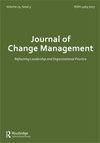‘Change is Our Continuity’: Chinese Managers’ Construction of Post-Merger Identification After an Acquisition in Europe
IF 3
Q2 MANAGEMENT
引用次数: 4
Abstract
ABSTRACT This article examines organizational identification construction in mergers and acquisitions (M&As). The majority of existing studies have focused on antecedents and outcomes of post-merger identification (PMI) in Western contexts. While more and more Chinese cross-border M&As are taking place, how Chinese employees construct PMI remains underexplored. We adopted a qualitative case study approach to investigate how Chinese managers construct PMI after acquiring a European company. As the main contribution, we introduce the concept of agile organizational identity (AOI), wherein agility is a central, enduring and distinctive characteristic of an organization, i.e. ‘who we are and who we want to be’. Our findings reveal that AOI is leveraged by Chinese managers to deal with their perceived inferior status, help them cope with the change and contribute to the construction of a strong PMI. We believe that our study provides a new perspective on how employees can effectively cope with organizational change while maintaining a sense of identity continuity. MAD statement This article examines organizational identification construction in mergers and acquisitions (M&As). We provide novel insights by introducing the agile organizational identity (AOI) concept, wherein the agility is a central, enduring and distinctive characteristic of an organization, i.e. ‘who we are and who we want to be’. To maintain such a pre-merger identity after M&As, people strive to continue changing as change is the continuity. Thus, psychological bonds between an employee and the employing organization do not become weaker. As agility is incorporated in the organizational identity, AOI helps employees to cope with the low status of their organization, accept organizational changes, and identify with the post-merger organization. Organizational leaders might want to foster AOI in order to successfully conduct strategic change initiatives.“变化是我们的延续”:中国经理人在欧洲并购后的并购后认同建构
摘要本文研究了企业并购中的组织认同构建。现有的研究大多集中在西方背景下的并购后识别(PMI)的前因和结果。虽然越来越多的中国跨国并购正在发生,但中国员工如何构建PMI仍未得到充分探讨。本文采用定性案例研究的方法,考察了中国经理人在收购欧洲企业后如何构建PMI。作为主要贡献,我们引入了敏捷组织身份(AOI)的概念,其中敏捷性是一个组织的核心、持久和独特的特征,即“我们是谁,我们想成为谁”。我们的研究结果表明,中国管理者利用AOI来处理他们感知到的劣势地位,帮助他们应对变化,并有助于构建强大的PMI。我们相信,我们的研究为员工如何有效地应对组织变革,同时保持认同感的连续性提供了一个新的视角。本文对企业并购中的组织认同构建进行了研究。我们通过引入敏捷组织身份(AOI)概念提供了新颖的见解,其中敏捷性是组织的核心、持久和独特的特征,即“我们是谁,我们想成为谁”。为了在并购后保持这种并购前的身份,人们努力继续变化,因为变化是连续性。因此,员工与用人单位之间的心理联系不会减弱。随着敏捷性被纳入组织身份,AOI帮助员工应对组织的低地位,接受组织的变化,并认同合并后的组织。组织领导者可能想要培养AOI,以便成功地执行战略变更计划。
本文章由计算机程序翻译,如有差异,请以英文原文为准。
求助全文
约1分钟内获得全文
求助全文
来源期刊

JOURNAL OF CHANGE MANAGEMENT
MANAGEMENT-
CiteScore
6.60
自引率
20.00%
发文量
14
期刊介绍:
Journal of Change Management is a multidisciplinary and international forum for critical, mainstream and alternative contributions - focusing as much on psychology, ethics, culture and behaviour as on structure and process. JCM is a platform for open and challenging dialogue and a thorough critique of established as well as alternative practices. JCM is aiming to provide all authors with a first decision within six weeks of submission.
 求助内容:
求助内容: 应助结果提醒方式:
应助结果提醒方式:


